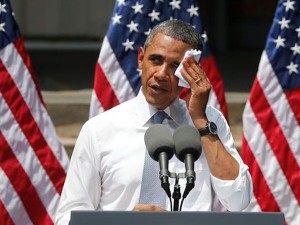How Obama’s power plant emission rules will work

This June 25, 2013 file photo shows President Barack Obama wiping perspiration from his face as he speaks about climate change at Georgetown University in Washington. The Obama administration is poised to unveil first-ever rules limiting greenhouse gas emissions from the power plants that dot the U.S. map. President Barack Obama says the rules are essential to curb climate change, but critics disagree. AP
WASHINGTON — The Obama administration on Monday plans to make public the first rules limiting carbon emissions from thousands of power plants.
The pollution controls form the cornerstone of President Barack Obama’s campaign to combat climate change and a key element of his legacy.
Obama says the rules are essential to curb the heat-trapping greenhouse gases blamed for global warming. Critics contend the rules will kill jobs, drive up electricity prices and shutter plants across the country.
Environmentalists and industry advocates alike are eagerly awaiting the specifics, which the Environmental Protection Agency will make public for the first time on Monday and Obama will champion from the White House.
While the details remain murky, the administration says the rules will play a major role in achieving the pledge Obama made in Copenhagen during his first year in office to cut America’s carbon emissions by about 17 percent by 2020.
Article continues after this advertisementSome questions and answers about the proposal:
Article continues after this advertisementQ: How does the government plan to limit emissions?
A: Unable to persuade Congress to act on climate change, Obama is turning to the Clean Air Act. The 1970s-era law has long been used to regulate pollutants like soot, mercury and lead but has only recently been applied to greenhouse gases.
Unlike with new power plants, the government can’t regulate existing plant emissions directly. Instead, the government will issue guidelines for cutting emissions, then each state will develop its own plan to meet those guidelines. If a state refuses, the EPA can create its own plan.
Q: Why are these rules necessary?
A: Power plants are the single largest source of greenhouse gas emissions in the US Environmentalists and the White House say without bold action, climate change will intensify and endanger the public’s well-being around the world. In its National Climate Assessment this year, the administration said warming and erratic weather will become increasingly disruptive unless curtailed.
“This is not some distant problem of the future. This is a problem that is affecting Americans right now,” Obama said in May.
The United States is only one player in the global climate game. These rules won’t touch carbon emissions in other nations whose coal plants are even dirtier. But the White House believes that leading by example gives the U.S. more leverage to pressure other countries to reduce their own emissions.
Q: How steep will the reductions be?
A: We don’t know.
The administration hasn’t said whether it will set one universal standard or apply different standards in each state. But Obama’s senior counselor, John Podesta, said the reductions will be made “in the most cost-effective and most efficient way possible,” by giving flexibility to the states.
That could include offsetting emissions by increasing the use of solar and nuclear power, switching to cleaner-burning fuels like natural gas or creating efficiency programs that reduce energy demand. States might also pursue an emissions-trading plan — also known as cap-and-trade — as several northeast states have already done.
Q: How will they affect power bills? What about the economy?
A: Different states have a different mixes of coal versus gas and other fuels, so the rules will affect some states more than others. Dozens of coal-burning plants have already announced they plan to close.
Still, it’s a good bet the rules will drive up electricity prices. The U.S. relies on coal for 40 percent of its electricity, and the Energy Department predicts retail power prices will rise this year because of environmental regulations, economic forces and other factors.
Environmentalists argue that some of those costs are offset by decreased health care costs and other indirect benefits. They also say the transition toward greener fuels could create jobs.
Q: Doesn’t Obama need approval from Congress?
A: Not for this. A 2007 Supreme Court ruling gave the EPA the green light to regulate carbon-dioxide under the Clean Air Act. But that doesn’t mean there won’t be fierce opposition and drawn-out litigation. The government is expecting legal challenges and is preparing to defend the rules in court if necessary.
Q: Is this the final step?
A: Not even close. After the draft rule is proposed, there’s a full year for public comment and revisions. Then states have another year to submit their implementation plans to the EPA.
RELATED STORIES
We need to act on climate change—Obama
Obama sees big reveal: Jeepneys out, Comet in
Obama to Congress: Act on climate change or I will